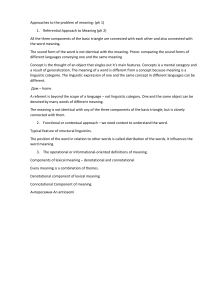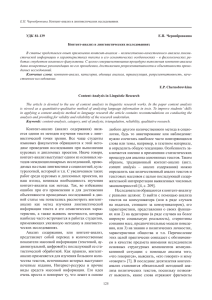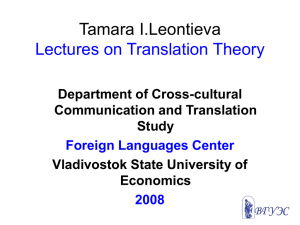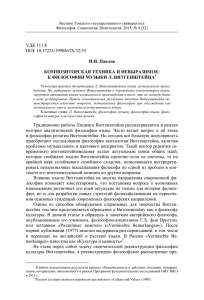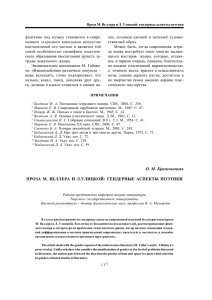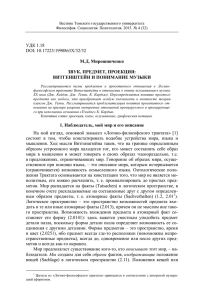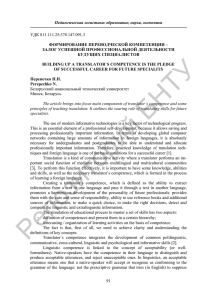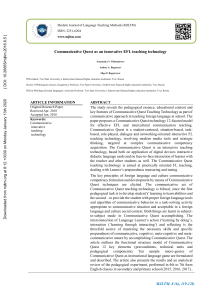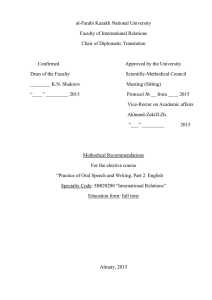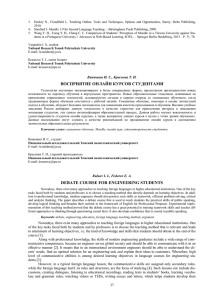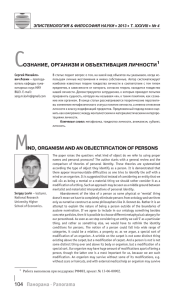Introduction-Metaphysical-and-postmetaphysical-relationships-of-humans-with-nature-and-life
реклама
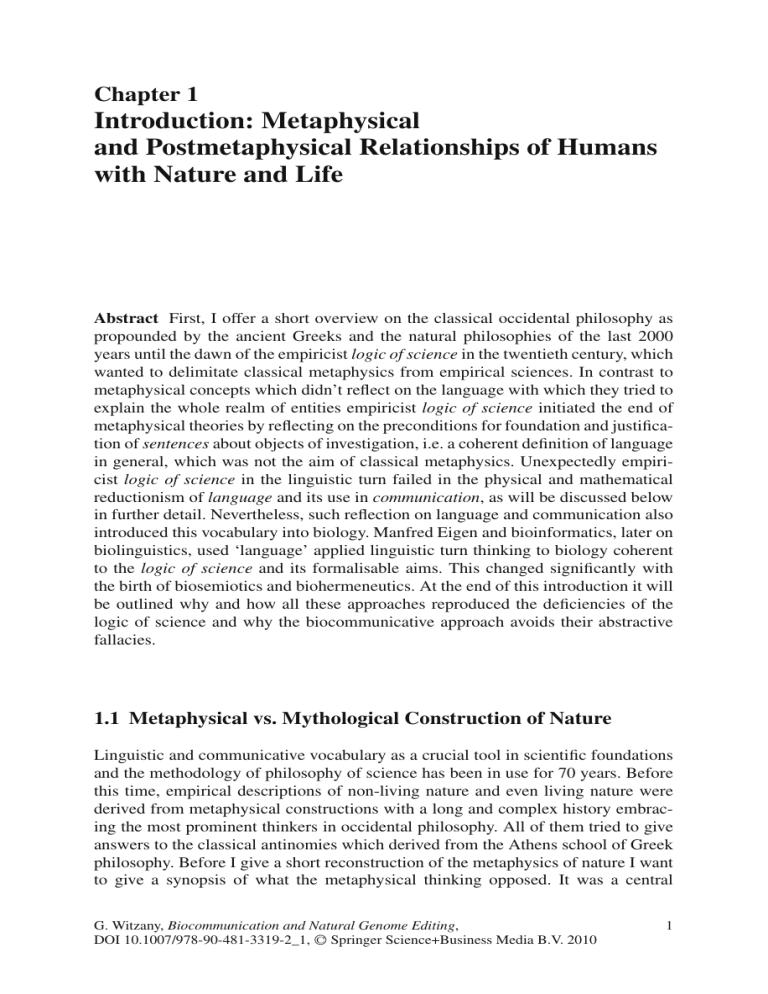
Chapter 1 Introduction: Metaphysical and Postmetaphysical Relationships of Humans with Nature and Life Abstract First, I offer a short overview on the classical occidental philosophy as propounded by the ancient Greeks and the natural philosophies of the last 2000 years until the dawn of the empiricist logic of science in the twentieth century, which wanted to delimitate classical metaphysics from empirical sciences. In contrast to metaphysical concepts which didn’t reflect on the language with which they tried to explain the whole realm of entities empiricist logic of science initiated the end of metaphysical theories by reflecting on the preconditions for foundation and justification of sentences about objects of investigation, i.e. a coherent definition of language in general, which was not the aim of classical metaphysics. Unexpectedly empiricist logic of science in the linguistic turn failed in the physical and mathematical reductionism of language and its use in communication, as will be discussed below in further detail. Nevertheless, such reflection on language and communication also introduced this vocabulary into biology. Manfred Eigen and bioinformatics, later on biolinguistics, used ‘language’ applied linguistic turn thinking to biology coherent to the logic of science and its formalisable aims. This changed significantly with the birth of biosemiotics and biohermeneutics. At the end of this introduction it will be outlined why and how all these approaches reproduced the deficiencies of the logic of science and why the biocommunicative approach avoids their abstractive fallacies. 1.1 Metaphysical vs. Mythological Construction of Nature Linguistic and communicative vocabulary as a crucial tool in scientific foundations and the methodology of philosophy of science has been in use for 70 years. Before this time, empirical descriptions of non-living nature and even living nature were derived from metaphysical constructions with a long and complex history embracing the most prominent thinkers in occidental philosophy. All of them tried to give answers to the classical antinomies which derived from the Athens school of Greek philosophy. Before I give a short reconstruction of the metaphysics of nature I want to give a synopsis of what the metaphysical thinking opposed. It was a central G. Witzany, Biocommunication and Natural Genome Editing, C Springer Science+Business Media B.V. 2010 DOI 10.1007/978-90-481-3319-2_1, 1 2 1 Introduction paradigm shift in human history: the change from a myth-based self-understanding with its focus on cultus and ritus and the strict hierarchy of norms and traditions within which a tribal society was interwoven. Pre-metaphysical hierarchies are mythology-based forces of creation. Nature was speaking to humans as animals and plants, natural forces as thunder, wind, water and fire. The order of the world was self-evident. Animals were not ranked inferior to humans but equally. As animals are different, so are humans different. The self-evident order of the world is a cosmocentric law which rules over animals and humans. The myth of the change of nature before humans to nature with humans does not resolve the status of nature without humans. The mythology of pre-metaphysical tribal societies suppresses destruction of nature definitively. Nature is a kind of holy being within which non-holy humans are embedded. Therefore humans have to act accordingly. Humans in pre-metaphysical tribal societies were not only ecological experts. Their educational systems were holistic ones, each member being required to be familiar with their surroundings such as plants, animals, climate, annual cycles and repetitions, interdependencies of the inner and outer nature. Each member of this kind of human society was also familiar with the ethics and norms of tribal traditions in social affairs. A different relationship with nature was constructed in the metaphysical thinking of the classical Greek philosophers. At the basis of the western occidental-modern world view and technical-scientific modernity we can find Greek cosmology. Their competing metaphysical world views are extensively developed constructions according to logics and methodology which offer completely different answers to questions of the myth-based lifeworld. The change from a natural being into a society-based being is an irreversible process. The division of survival of society, of the survival of non-human nature, indicates a newly-derived hierarchy in which culture (i.e. inner nature of humans) has primacy in opposition to nature (outer nature). The subordination of society to an omnipotent creator god and his plan of creation are followed by the subordination of non-human nature to the human one. The hierarchy is strict and structured: the primacy of gods, followed by humans and, last, the rest of nature. The age of unity between human mankind and nature is broken irreparably. The order of the world is no longer self-evident but offered by god and supernatural. God is thinking prime pictures whose depictions are manifested in a great variety here on earth and in the cosmos (Capelle 1968). The invention of the general term as crucial tool of the technique of abstract thinking divides metaphysical interpretation of nature clearly from the premetaphysical one. The rationalisation of world views occurred in parallel with differentiation and complexity of writing. Development and practice of the technique of writing liberated transport of tradition from the ancient practice of vocal traditions. Now it was possible to read about the history and myth of tribal societies even if they were far away or no longer present. Metaphysical philosophy of nature from now on had to answer the questions of classical antinomies, the relation between the whole and its parts and between (statical) being and (dynamical) becoming. 1.1 Metaphysical vs. Mythological Construction of Nature 3 There are three mainstream conceptions within metaphysical philosophy of nature in the occidental tradition of philosophy of the last 2000 years. All philosophical conceptions of the last 2000 years are part of one of these mainstream paradigms.1 We differentiate: • Monistic-organismic world views • Pluralistic-mechanistic world views • Organic-morphological world view 1.1.1 Monistic-Organismic World Views The main principle of all monistic-organismic world views is holism (all is one). What we experience as a broad variety of things and processes constituting this world is attributed to one main principle. The multitude of beings is within this world view deduced from one driving force. Cosmos is a whole, the many things are epiphenomena which seem to be many but in reality are only parts of the whole. Inside and outside are two aspects of the one and whole reality. What seem to be many are only different moments of the one and all. According to different wholes in this monistic organismic world view (Life, soul of the world, world-mind, god) there is a differentiation between a physical, metaphysical or pantheistic monism. If the main principle is life we speak about hylozoism, if it is the soul, panpsychism, if it is divine, pantheism. In all of these monisms there is one and only one main principle which is behind all things. In the history of philosophy we can differentiate different developments of these monisms such as pre-Socratic hylozoism (Thales of Miletus, Anaximenes, Heraclitus), cosmic pantheism of the Stoa (Seneca, Epictetus, Marcus Aurelius, Cicero), pantheistic emanantism of Plotinus (Ammonius Sacca, Plotinus, Scotus Eriugena and later on Spinoza, Hegel), aesthetic pantheism of Giordano Bruno and his monadology, which was further developed by Leibniz and the precritical Kant in his metaphysical dynamism, and later on Hamann, Kierkegaard, Schelling, Goethe, Novalis, Hölderlin, Rilke, Steiner. In a certain sense, this monistic world view is exemplified also in rationalism with its objection that the whole world can be imagined as and integrated within one objective and logical system which we must solely investigate long enough to integrate all things into this one and only system, as thought by Spinoza. This thinking also attracted Hegel. The god of Hegel is living and organismic and emerges as world through dialectical processes of birth, death and next level of being. In its organismic variation we find monistic evolutionism in Clifford, Huxley, Darwin and Spencer. One law determines the whole universe. This absolute unifying law is the law of development. Differentiation and Integration are the everlasting potentials of this law. The Emergentism of Samuel Alexander postulates the one and only world matter which is the material out of which all things are formed. The many parts and 1 The outline of the three metaphysical world views follows Zeno Bucher (1982). Natur, Materie Kosmos. Eos, St. Ottilien. 4 1 Introduction processes are events which are emerging out of this world matter which is at the last identical with god. Another much younger philosophy is the panvitalistic metaphysics of France with Maine de Biran and Bergson. From its strict anti-mechanistic and antirationalistic view they propagated a self-enforcing power of all living, or as Bergson called it, the Bios, the principle of creation in the whole reality which is the driving force of the whole universe. This vitalism is integrated within certain other holisms which tried to unify this world view with modern natural science knowledge and such proponents as Haldane, Meyer-Abich, Wheeler, Whitehead, Bohm, Capra. Another kind of organic monism is the dialectical materialism of Engels which is a counterpart to Hegel’s idealistic monism. The whole and the one is more than the sum of its parts. The parts per se have no value, only in sum the whole is the main value. The monistic-organismic world view is present also in twentieth-century physics. Searching for the last common invisible matter, or the elementary parts of all matter or the last and one formula (Stephen Hawking) through which all can be explained or which represents the ultimate law of all being, are variations of ‘all is one’ – metaphysics. The particles on the subatomar level are not parts by their own. They are parts which are all constituted by lower parts and smaller parts and at the last they are quantums, quantum parts (Heisenberg 1973) or, as Einstein noted 1950, electrical field densities which we see as corpuscles but in reality are condensed out of a universal field of energy. The driving force of these monistic-organismic world views derives from both the presumption of the unification of thinking and being (without language’s critical reflection) and a kind of idealistic rationalisation of experiences such as separation, transitoriness, contradiction, fear of reality and the new, unexplainable. The many parts we experience are at the last all in one, a common principle, the last and ultimate law and formula or in its theistic variation basics of all religious social orders (Wittgenstein 1975: 80e). 1.1.2 Pluralistic-Mechanistic World Views In strict opposition to the monistic-organismic world views there are the pluralistic mechanistic ones. Their main principle is: all is endless plurality (all is many). In contrast with the holistic one and only of monisms, in the pluralistic all is built of indefinite numbers of corpuscles, smallest parts. If we look at or experience things, persons, objects, they seem to be entities, but in reality they are the sum of these smallest corpuscles. These last smallest entities are unchangeable and everlasting. A real becoming out of nothing, i.e. a real de novo emergence which means a movement from not being into being may be a construction in our consciousness but has nothing to do with any reality. These ultimate single corpuscles can be brought into forms or can even be mixed but this does not change anything within them. In their outer nature they can be moved and change their relation to one another but in their substance they are unchangeable. Any movement is caused from outside and is 1.1 Metaphysical vs. Mythological Construction of Nature 5 purely mechanistic. Parmenides was one of the first thinkers to propound this world view. For him movement is also an illusion because it is a line-up of the smallest unmoved statical state of things. A hundred years later the atomistic school changed the philosophy of Parmenides in one crucial aspect. Leukippus and Democrites now believed the experience of multiplicity, changeability and movement to be reality. The hylomorphistic conception of Aristotle damaged this world view until it was revived by Pierre Gassendi in 1649. He constituted the philosophy of mechanistic atomism in a new way. Robert Boyle described this mechanistic atomism. He observed that in contrast with older forms of atomism matter is an assembly of different basic elements. His philosophy focused on investigations and research into these basic elements. A hundred and fifty years later Proust and Dalton postulated real atoms in the so-called law of constant and multiple proportions. Then the term molecules was developed and in the shift to the twentieth century it became increasingly clear that atoms are not atoms, because they are constituted by a variety of dynamic entities which can emerge as corpuscles or waves. This contradicted the term atom fundamentally. Although atomism was shown to be a misinterpretation of nature, Mechanism as mechanism has been a successful model until today. René Descartes observed earlier that the concept of indivisible corpuscles is dubious in principle. Rationalistic investigation can experience only mathematical relations and the reality of matter can only be viewed as proportion and dimension. We can only understand machines because all their functions can be reconstructed by investigation of the function of their parts. These parts of the world machine first are thought by god and later on produced. The parts of being within Descartes’s thinking are purely dimensional and equal. Behind these qualities of the ultimate parts there is nothing else. They can be differentiated only in their size, geometry and configuration. Every phenomenon in the cosmic universe is a configuration and local movement of these parts. Additionally all living beings function in the same way, purely mechanistically. Descartes’s strict mechanisation of everything within nature became a broad mainstream world view. The principles of mechanics were adapted to whole physics and as result this kind of physics became the basic science of all empirical research and investigation. A late player was Newton, whose philosophy was founded on mechanistic principles. According to Newton, ultimate particles are created by god as massive particles. From this, the next step was the apodictic mechanism of LaPlace, who stated that every single status within the world and cosmos is a strict effect of the foregoing causes. If there were a mind which could oversee all forces which are existent in nature it would be able to predict every future development out of this knowledge, because everything happens according to strict mechanical laws (the LaPlace demon). Then came a state of universal determinism: the state of every closed system at a certain moment determines the following development for all time. The whole world as well as the universe is a big machine, which is constituted by an infinite quantity of parts, all of them underlying strict natural laws. With strict rational 6 1 Introduction thinking nature has to be analysed in minutest detail until all parts of nature are part of scientific knowledge. Then sometimes mechanical nature can be reconstructed completely and even optimised, unlike real nature. This is also valid for all living beings including humans, especially the human mind. This was a basic conviction also of Dubois-Reymond, one of the main mentors of Sigmund Freud. In the twentieth century, Rudolf Carnap was also convinced that the psychological features of humans are a bundle of physiological mechanistic single processes and should be explained mechanistically. 1.1.3 Organic-Morphological World View In between these two completely contradictory world views there is a third world view which was worked out by Aristotle and later on by Thomas Aquinas, and has been further developed in the twentieth century by the school of Neo-Thomists like Nikolai Hartman, Aloys Wenzl, Hedwig Konrad-Martius and others. The startingpoint of the so-called organic-morphological world view is the theory of levels, which includes a categorisation of the delimitations and differences between these levels. Hartman distinguishes four levels of being: the material, the vital, the psychic and the mental. These levels differ in their stages on the way to perfection which depend on the translation of potentiality into actuality. In the level of the material, the potentiality is dominating, actuality is less, i.e. the real matter of the world behaves according to natural laws, e.g., in the case of nuclear technologies, much more actuality can be processed out of single atoms. In a nuclear chain reaction actuality is nearly indefinite whereas potentiality approaches zero. The higher level integrates the lower one, although the lower one is not dissolved but gets a new function within the higher one. This means reality is constituted by many and ultimate smallest particles which develop in real processual reality into different forms which unite to become such things as bodies of living beings. This organic morphological world view strictly contradicts the monistic-organismic as well as the pluralistic mechanistic world view. The relationships between these levels are determined by a set of laws: 1. Law of autonomy: according to Hartmann, each layer of being is autonomously structured and the genesis of this autonomy cannot be fully derived from the next lower level. The mental level is therefore independent of the psychic level, the psychic of the vital, and the vital of the inorganic. This does not necessarily mean that the mental level lacks the psychic level, the psychic level lacks the vital one and the vital lacks inorganic elements. Rather it emphasises that each of these levels is characterised by features that can be found here and only here. Within this law of autonomy there are two subordinate laws. (a) The law of novelty: in each higher level, features appear which are lacking in the next lower level. These features represent a novelty, something new compared with the lower level. Such new features are neither a logical consequence in the development from the lower to the higher level nor can they be fully derived from the former. (b) The law of modified, recurrent features: the laws of the lower level reappear in the higher level, never vice 1.2 Delimitations Against Metaphysics 7 versa, but in a modified manner. Specifically, the laws of the lower are structurally and functionally integrated into the higher. For example, the laws of the inorganic level recur in the vital level, but under organisational principles of the vital level, i.e. in a constellation unknown in the inorganic level. 2. Law of dominance: the laws specific to one level do not merely govern that layer. Within the overall organism, every higher level acts on all levels below it, without dismantling or negating them. Humans, for example, possess a vegetative nervous system whose function is largely independent of mental activity. This mental activity, however, can influence the psychic state and, by destabilising it, e.g. in extreme stress situations, have an effect on the vegetative nervous system. 3. Law of dependence: each higher level is neither poised above nor determined by the lower ones, although a certain dependence does exist. The mental level functions on the basis of the psychic, this on the vital, and the vital in turn on inorganic substances. In the case of comatose patients, the vital level and the vital organisation of the inorganic matter comprising the body continue to function, but the psychic and mental levels are silenced. 4. Law of distance: owing to the new, defining quality of a level of being, Nikolai Hartman recognises a ‘metaphysical discontinuity’ rather than actual transitions between these levels. While representatives of approaches based on continuity theories have always postulated such transitions, no actual transitions have been found or convincingly reconstructed in the field of palaeontology. According to this law, nature, and even evolution, progresses in discrete steps. In contrast with the former two most prominent world views with their ‘all is one’ or ‘all are part’, in this different worldview being is a kind of processual reality with developmental stages from simpler to more complex structures. Also in contrast with the former conception, the occurrence of novelty which did not exist before is a special feature of being and cannot be logically or ontologically deduced from former stages. Movement, development, changeability from the littlest inorganic parts up to the human mind is an inherent potentiality of being and not a mere epiphenomenon or mixture of unchangeable smallest beings. The differences between the organic morphological world view and the monistic-organismic and pluralistic-mechanistic world views are fundamental and unbridgeable. 1.2 Delimitations Against Metaphysics All schools of philosophy from antiquity and the classical Greek age up until the twentieth century tried to solve the classical problems of antinomy, i.e. (i) the relationship of the whole and its parts and (ii) the (statical) being and the (dynamical) becoming. The short overview of the philosophical conceptions, their tendencies and motifs described a kind of philosophy which was to be strictly avoided by the philosophy of science called logical empiricism (neo-positivism) and later on critical rationalism. The whole dictionary and language game played in these metaphysical languages was a real nightmare for the proponents of the project of ‘exact science’. 8 1 Introduction They were convinced they could find a language which could both exclude metaphysical language, inexact terms and apodictically-claimed truth and for the future express empirical sensory data unambiguously and definitively. For logical empiricism metaphysical questions do not have any subject and therefore replace this kind of philosophy by the primacy of empirical scientific knowledge, materialism and naturalism. As we will see later, both the idealistic tradition and it materialistic counterpart and even empirism share classical metaphysical positions such as (i) their claim of being an original philosophy and (ii) the identification of being and thinking. The latter one particularly constructs an inner relationship between thinking and being: as we are thinking, being also functions. The general, the necessary and the supratemporal can be found also in their terms. Empirism and Nominalism identified this self-misunderstanding. They resolved this misunderstanding in a multitude of entities without qualities. Only by the sensory organs of feeling subjects can these entities be mentioned and then be reconstructed within their imaginative apparatus. Modern empirism wanted to be freed from these metaphysical implications by a substantial and fundamental critique of metaphysics. Therefore the only serious value for science is the rationality of the methods of scientific knowledge, i.e. the formalisable expression of empirical sentences. This is strict objectivism, which restricts itself to a pure observer perspective that confirms its observations by techniques of measurements and subsumes reality in the formalisable depiction of these measurements. Between metaphysics and objectivism there is an unbridgeable gap: what can be found empirically and described as formalisable exists. Outside these criteria everything can be believed but is not the subject of exact sciences. From now on objectivity is the main agenda of natural sciences, subjectivity the subject of human sciences. The interesting and ambitious programme of logical empiricism started as no scientific discipline started before: by a fundamental critique of the sentences with which we describe observations and those with which we construct theories. This scientific approach was a fundamental shift in the history of philosophy. In the main focus were not the things, the world, the being but conversely the medium in which we describe our opinions, impressions, experiences, the language itself. 1.2.1 Linguistic Turn To delimitate exact scientific sentences from inexact sentences as they occur in philosophy and theology, the school of logical empirism (Carnap 1931a, 1931b, 1934, 1939, 1956, 1966; Neurath 1932; Gödel 1931, and later on Russell 1940; Tarski 1966) at the beginning of the 1930s tried to construct a formalised language of exact sciences according to the young Ludwig Wittgenstein and the theoretical construction which he outlined in Tractatus Logico-Philosophicus (Wittgenstein 1959). With this formalised language of exact sciences it should be possible to outline empirical results of experimental research exactly and without ambiguity. This means that every sentence with which observations are described as well as sentences which are 1.2 Delimitations Against Metaphysics 9 used to construct theories must fulfil the criterion of formalisability, i.e. they must be expressible as mathematics. Only sentences which fulfill this criterion should be claimed as (termed as) scientific. Sentences which would not be formalisable have to be excluded from science because they are not scientific sentences. By this procedure natural science should be installed as exact science. Because the world functions exclusively according to the laws and principles of physics, this world can be depicted only by sentences of mathematics which are able to express physical reality in a one-to-one manner. Natural laws expressed within the language of mathematics, i.e. formalisable, represent the inner logic of nature. The central part and most important element of language therefore is the syntax, because only by the logical syntactic structure of language is it possible to depict the logical structure of nature. Language as depiction of the natural laws of reality therefore must be formalisable in all its aspects. Because language therefore is seen as a quantifiable set of signs it can be expressed also in binary codes (1/0). Meaning functions therefore are deducible solely from this formal syntactic structure. Similarly to this model of language, cybernetic system theory and information theory investigate the empirical significance of scientific sentences out of a quantifiable set of signs and, additionally, out of the information transfer of formalised references between a sender and a receiver (sender-receiver narrative). Informationprocessing systems therefore are quantifiable themselves. Understanding information is possible because of the logical structure of the universal syntax, i.e. by a process which reverses the construction of meaning. Because of this theorem, information theory is also a mathematical theory of language (Shannon and Weaver 1949; Turing 1950). Both constructions are founded on the assumption that reality can be depicted in a one-to-one manner only by formalisable procedures, i.e. formalised sentences. Exact sciences means correspondence of thinking and being. Manfred Eigen adapted these models for biology in the last third of the twentieth century in the description of the genetic code as a language-like structure (Eigen and Winkler 1975). 1.2.2 Manfred Eigen’s Adaptation of the Linguistic Turn to Biology Manfred Eigen compares human language with molecular genetic language explicitly.2 Both serve as communication mechanisms.3 The molecular constitution of genes is possible, according to Eigen, because nucleic acids are arranged according 2 ‘Speech, communication, reading and comprehension on this level mean binding (=recognising) the complementary molecular building blocks (=language symbols) and linking them into a macromolecular ribbon (=text)’ (307). 3 ‘Each language primarily reflects the characteristic features of the respective, underlying communication machinery’ (313). 10 1 Introduction to the syntax and semantics of this molecular language. 4 Even the amino acid sequences constitute a linguistic system.5 Through this comparison Manfred Eigen follows the depiction theory of language within the tradition of empiricism, logics, mathematical language theory, cybernetic systems theory and information theory. The world behaves according to physically determinable natural laws. These natural laws can be expressed only by using the language of mathematics. The formalisable artificial language of mathematics is alone capable of realistically depicting these natural laws. Language in its fundamental sense is language as a formalised sign language. The natural laws are explications of the implicit order of mathematics and nature. Mathematical language depicts this logical order through the logical structure of the linguistic sign system. The essential level of rules of a language therefore is the syntax. Only through the syntax does the logical structure of a language as a depiction of the logical structure of nature come to light. Because both the identity of the logical order of the language in its syntax and the logical order of nature can be expressed in mathematics, this language is quantifiable and can be expressed in binary codes (1/0). The semantic aspect of language initially comprises an incidentally developed or combined sign sequence, a mixture of characters, which only gain significance in the course of specific selection processes. The linguistic signs are variables whose syntax is subject to the natural laws governing the sign-using brain organ. The brain of humans, for example, is endowed with these variables and combines them to reflect synapse network logics. The variable sign syntax of the brain then must be filled up with experiences of a personal nature and thus constitutes an individualised evaluation scheme. In messages between communication partners, one side encodes the message in phonetic characters. The receiver must then decode and interpret the message based on empathy and personal experience. Understanding messages shared between sender and receiver is largely possible because the uniform logical form – a universal syntax – lies hidden behind every language.6 The function of that organ which syntactically combines the language signs according to its own structure most closely corresponds in Eigen’s opinion to cybernetics, i.e. the theory of information-processing systems (while abstracting the manner of its realisation). Functional units like the central nervous system, brain or even macromolecules consist of a definable, limited number of elements and a 4 ‘The relative arrangement of the individual genes, the gene map, as well as the syntax and semantics of this molecular language are (. . .) largely known today’ (207). 5 ‘Although the active center – the actual three-dimensional word correlate of the protein language – comprises no more characters than the number of verbs in spoken language, the protein molecule must unite a total of between one to five hundred chain elements within itself in order to form such an active center, each one of these molecules represents a particular task and one could describe the enzymes as the ,verbs’ of the molecular language’.(305) ‘(. . .) All the words of the molecular language are combined to a meaningful text, which can be broken down into sentences’ (305). 6 ‘. . .sentence structures, if we disregard the specific peculiarities of the individual languages, exhibit parallels that indicate a universal regularity evidently originating in the organization of the human brain’ (301). 1.2 Delimitations Against Metaphysics 11 limited number of relationships between these elements. These systems, along with their description by means of a language, are depictions of a reality, structured by natural laws. Since both the logic of the describing and that of the theory constructing language correspond with the logic of the system, the relationship between these elements of the system can be represented in an abstract, formal and unambiguous manner. From the perspective of man as a machine, humans clearly represent an optimal model: they fulfil all those preconditions for constructing algorithms that a conventional machine cannot deliver, i.e. criteria for information evaluation based on the real social lifeworld.7 Humans, and all other biological systems, resemble a learning machine capable of internally producing a syntactically correct depiction of the environment by interacting with this environment, of correcting this depiction through repeated interactions and thus of changing their behaviour according to the environmental circumstances. Such learning systems are able to continuously optimise their adaptability.8 The differences between nucleic acid language and human language stem from the continuous developmental processes of biological structures, based on the model of a self-reproducing and self-regulating automaton that functions as realisations of algorithms.9 This enables the steady optimisation of problem-solving strategies in organisms, eventually leading to the constitution of a central nervous system, a precursor ultimately giving rise to the brain and its enormous storage and information-processing capacity. Language enables the implementation of this evolutionary plan (from the amoeba to Einstein): this medium forms, transforms, stores, expands and combines information.10 1.2.3 Deficiencies of Manfred Eigen’s Depiction Theory of Language Even formal systems are not closed, as Eigen suggests, nor are they principally fully determinable. Furthermore, language is the result of communicative interactions 7 ‘Nature, through the development of receptors that register environmental signals and through the development of nervous systems that can process and store such signals, has found a more economic way’ (225). 8 ‘A specific operational task of the von Neumann automaton is self-reproduction. The first model from the year 1950 was entirely realistic in its conception: the machine runs back and forth in a huge spare-parts warehouse and compiles the components necessary for its own replication. Most importantly, it also reproduces its own construction plan or blueprint. Its progeny should, after all, also be equipped with the self-reproduction capability. Herein lies the possibility to perfect the von Neumann automaton, an idea that has long been taken up by theoreticists: selective alteration of the program enables continuous improvement and an expanded range of application in the sense of Darwinian evolution’ (216). 9 ‘In principle, the automaton is capable of carrying out any desired calculation’ (217). 10 ‘At any rate one can say that the prerequisite for both great evolutionary processes of nature – the origin of all forms of life and the evolution of the kind – was the existence of a language’ (314). 12 1 Introduction in dialogue situations rather than the result of constitutive achievements of the individual persons. Communicating with one another, sending messages, understanding expressions is not a private coding and decoding process, but rather an interpretation process arising from a mutual adherence to rules by communicating partners who agree on the rules. The ability to abide by these rules is innate, the skill in complying with particular rules is acquired through interactions and relies on norms of interaction to utilise words in sentences, i.e. a linguistic competence. Information cannot generally be quantified as message content: statements made by social individuals in situational contexts are not closed and, thus, are generally not fully formalisable. The attempt to construct a purely representational language is doomed to failure because formal artificial languages do not exclusively contain terms that are unambiguous. This pertains to terms that cannot be confirmed through observation. Specifically, scientific statements are not attributable to immediate sensory experience, i.e. the language game used to describe observations does not mirror the brain activity during the perception of reality. A world-depicting exact language must remain a mere postulate because it cannot logically substantiate itself. Too many theoretical concepts, too many scientific criteria that are generally not formalisable (e.g. ‘progress in the cognition process’, ‘practicability’, etc.), point to the limits of formalisability. The very identity between artificial language and its form renders it incapable of reporting on itself, something that presents no problem when informal speech, i.e. everyday language, is used. Language is an intersubjective phenomenon which several individuals can share, alter, reproduce as well as renew the rules of language usage. The basis and aims of this usage are defined by the real social lifeworld of interacting life-forms. The user of a linguistic sign cannot be comprehended according to the speaker-outside world model. Rather, this requires reflection on the interactive circumstances to which the user has always been bound, circumstances which provide an underlying awareness enabling him/her to understand statements made by members of the real lifeworld. The user of formal artificial languages – before appreciating the purpose of the usage – has also developed this prior awareness in the course of interactive processes with members of the real social lifeworld. Speech is a form of action, and I can understand this activity if I understand the rules governing the activity. This means I can also understand an act that runs counter to the rules. Everyday language usage reflects everyday social interactions of the constituent individuals. The prerequisite for fully understanding statements is the integration of the understander in customs of social interaction and not merely knowledge of formal syntactic-semantic rules. A prior condition for all formalisations in scientific artificial languages is a factual, historically evolved, communicative experience. This very precondition becomes an object of empirically testable hypothesis formation in Eigen’s language model. At this point, however, Eigen’s model becomes paradoxical because he seeks to grasp theoretically language with tools that are themselves linguistically predetermined. Eigen’s language model, which is rooted in information theory, clearly reveals that Eigen equates the form of theory language with the form of language used 1.2 Delimitations Against Metaphysics 13 to describe reality (experience). This implies the equation of formalised scientific languages with the language used to describe observations. Previous attempts to specify all the rules governing the translation of every term in theory-language into terms of observational languages have been unsuccessful. Not all concepts of theory language can be transposed into concepts of the observational language. 1.2.4 Gödel’s ‘Incompleteness Theorem’ and Real-Life Languages A similar situation (but more than 40 years before Eigen) is encountered in the attempt to absolutise mathematics as that pure formal language whose every ramification might become fully transparent. This led Gödel to formulate the Unvollständigkeitssatz (incompleteness theorem) in his work Über formal unentscheidbare Sätze der principia mathematica und verwandter Systeme (1931). Gödel investigated a formal system by applying arithmetic and related deduction methodologies. His aim was to convert metatheoretical statements into arithmetical statements by means of a specific allocation procedure. More precisely, he strove to convert the statements formulated in a meta-language into the object language S by using the object language S. This led Gödel to two conclusions: 1. On the assumption that system S is consistent, then it will contain one formally indeterminable theorem, i.e. one theorem is inevitably present that can be neither proved nor disproved within the system. 2. On the assumption that system S is consistent, then this consistency of S cannot be proved within S. The question of determinability and calculability is closely allied with the algorithm concept, whereby Eigen seems to postulate that algorithms are not only concepts of theoretical language, but also depict (decision-) behaviour in the realm of biology and, therefore, are amenable to empirical analysis. Indeed, he is convinced that everything can be represented in the form of algorithms and can thus, in principle (after sufficiently thorough analysis), be determined. Yet Eigen never puts this to the test, i.e. he never states the conditions in which a branch of mathematics would be indeterminable. Namely, a field of formalised artificial language is indeterminable when no algorithm can be provided to help one to decide – for a particular formula of a formalised artificial language and involving a finite number of steps – whether this formula is universally valid or not. Today, several branches of mathematics are considered indeterminable. Herein lies the consequence of this indeterminability theorem for the automaton theory of A. Turing and J. v. Neumann: a machine can principally calculate only those functions for which an algorithm can be provided. Functions lacking an algorithm are not calculable. Every cybernetic, self-controlling machine is the realisation of a formal system. Eigen assumes that the evolution of self-reproducing and self-organising organisms represents the realisation of the syntax of a universal language underlying the order of the world. This universal syntax, as a representation of mathematically expressible reality, is also the formal basis for the evolution of these organisms. For each of 14 1 Introduction these machines, as in the case of every organism, there must be an indeterminable formula. It is precisely by means of a non-formal language that this formula can be shown to be true or false; this non-formal language is the very tool that enables the language itself to be discussed. The machine is unable to do this because no algorithm is available with which a cybernetic machine can determine its underlying formal system. Systems theory is principally unable to fulfil the demands that Eigen places on it. The fact that the paradoxes arising within a formal language cannot be solved with that language led to a differentiation between object language and metalanguage. Nonetheless, paradoxes can also appear within meta-language; these can only be solved by being split into meta-language, meta-meta language and so forth in an infinite number of steps. This unavoidable gradation of meta-languages necessitates resorting to informal speech, developed in the context of social experience, as the ultimate meta-language. It provides the last instance for deciding on the paradoxes emerging from object- and meta-languages. Neither the syntax nor the semantics of a system can be constituted within that particular system without resort to the ultimate meta-language. The ambition to provide logic and mathematics with a priori validity is no longer tenable: an unambiguous linguistic foundation of science, one beyond further inquiry and supporting itself through direct evidence, cannot be secured. Language proves to be a perpetually open system with regard to its logical structures and cannot guarantee definiteness from within itself. This is the very conclusion that Eigen disputes with his language model. To summarise this chapter: • There can be no formal system which is entirely reflectable in all its aspects while at the same time being its own metasystem. • Concrete acts and interactions are basically unlimited in their possibilities. There will always be lines of argumentation that lie outside and have no connection with an existing system. Basically, every system can be transcended argumentatively. Newly-emerging language games and rules may develop as novel structures which are foreign to previous systems and not merely a further step in a series of prevailing elements. These very discontinuities enable totally new language applications. • The ultimate meta-language, informal language, provides indispensable evidence about the communication practice of subjects in the real environment; the operator of formalisations is itself an integral part of this. Reverting to this everyday type of communication reveals information about the subjects practising this usage. In this sense, pragmatism becomes the theoretical basis both for formal operation and for a non-reductionistic language theory. Manfred Eigen was correct in recognising that language and communication were and continue to be indispensable for the origin of life, the developmental processes of biological organisms, as well as for the specifically human capacity for thought, speech, and action; at the same time, he is unable to provide an adequate foundation for these two terms. This casts doubt on the entire explanatory model for living nature as provided by the biological disciplines. 1.3 The Roots of the Idea of an ‘Exact’ Scientific Language 15 1.3 The Roots of the Idea of an ‘Exact’ Scientific Language Logical empiricism and critical rationalism fail in their attempt to construct a pure language of logics and mathematics as delimitation from non-scientific, metaphysical sentences. The failure is hidden in their own metaphysical concept of language upon which they cannot reflect, because they reduce the main structures of language and communication to the syntax alone. Let me reconstruct the developmental history of this misconception of language. The origin of this can be clearly identified in the depiction theory of language of Plato. He was convinced that cosmos and the world can be sufficiently depicted by mathematics (following Pythagorean motifs). This clearly derives from his concept of ideal archetypes (the thoughts of god) which we find in this world in a variety of inexact depictions. With his language (mathematics) mankind can participate in these thoughts of god, i.e. the ideal archetypes. Aristotle shares the view on language as a tool, but in a crucial aspect he changes Plato’s conception: language acts as expression of the inner conceptions; the logical order of the linguistic sign system we use represents the logical order of nature in general. Here in the idea of an ideal language which can depict nature in a oneto-one depiction are the basics of the concept of the exact scientific language. The Aristotelian tool ‘language’, which functions like the tools with which we calculate mathematically, was further developed by Hobbes and Leibniz, who investigated this relationship between language and mathematics. Leibniz’ intention was similar to that of his twentieth-century peers: to define a syntactic-semantic construction of our thinking in symbols and therefore to reject all misunderstandings and obscurities within sciences. Even the concept of the young Wittgenstein postulates that behind the everyday language hides the logical form of a universal language (as postulated by Leibniz). Within this logical form of the language we can find the intersubjective and valid depiction of the fundamental facts. We have to express such fundamental facts by using these elementary sentences (Elementarsätze). By using these elementary sentences we can reconstruct any sensible sentences logically. The meanings of words within a language are presumed as non-variable substances which are coherent with material substances. Exactly at this point the modern empirical concept of language is congruent with the metaphysical conception of Aristotle. This is the basics of the theory that language does not transport real contents but structures exclusively: the signs which are used within a language are variables, which have to be filled up (similar to an empty container) by communication partners from their pool of private experiences. Therefore communication is a process which starts with private encoding activities, technical transmission via a medium or communication channel and last but not least the private decoding of the receiver (sender-receiver narrative). The interpretation of certain contents being transported in the messages is purely a private matter. The unchangeable thing, the material reality, is only the logical structure of the used language. The starting-point, again, is the Aristotelian logic of subjects and predicates which is the real depiction of the order of being. This has been picked up by scholasticism: ontology, the order of being, can be depicted in the Latin language. As noted 16 1 Introduction before, according to Leibniz, this should produce a pure and logical form of speech which should lead to his programme of characteristica universalis independently of any meaningful content working as a universal language of sciences. (Note that here we can find Chomsky’s concept of a meaning-independent, syntactical structure of universal syntax) This is exactly the purpose defined by the young Wittgenstein: to depict objective reality by one language, the language of mathematics and logic. 1.4 Postmetaphysical Thinking: Pragmatic Turn Self-definition of the ‘exact’ sciences was inherently presumed to reduce every observation on this formalisable universal language. Unfortunately this failed. All attempts to translate all terms with which we express observations in terms of the theoretical language demonstrated that this was not possible in an exact way. The universal depicting language remained as a postulation that could not satisfied by real processes. Metaphysics by itself was the basis of the criticism of metaphysics by the young Wittgenstein. The depiction of the world by logical atomism (Russell’s and Whitehead’s Principia mathematica) was unmasked as secret metaphysics of logic itself. The supposition of an ‘identical logical structure of language’ which constitutes intersubjectivity a priori can only be simulated in computerised models in artificial binary code languages which are based on formalisable procedures. But this has nothing to do with social praxis and socially shared lifeworld of human beings. The real-life everyday language can even speak about itself; it is its own meta-language. This is not possible for identical artificially constructed languages of science, which cannot be their own meta-languages coherent with their own definition. 1.4.1 The End of Linguistic Turn In his later work, Philosophical Investigations, Wittgenstein refuted the concept which he worked out earlier. The main characteristic of this pragmatic turn was the abandoning of the ideal of a world-depicting universal language. In contrast to former concepts which thought that behind any language is a material reality which determines the visible order of languages (e.g. universal laws, universal syntax) Wittgenstein proofed, that this is not the case. The most essential background of language is its concrete use in interacting humans. The real use of a language is always the unity of language and actions. This unity of language and actions Wittgenstein called Sprachspiel (language game). Game, because as in every game so also in language there are valid certain rules. It is not possible to go behind the practice of a life-form through explanations or foundations. Language itself is the last bastion as the real practice of actions. 1.4 Postmetaphysical Thinking: Pragmatic Turn 17 Language as practical action is an intersubjective phenomenon. To insist on this fact and to demonstrate that methodological solipsism is unsuccessful in principle Wittgenstein worked out the proof of the impossibility of a private language.11 In his analysis of the expression ‘to obey a rule’, Wittgenstein provides proof that the identity of meanings logically depends on the ability to follow intersubjectively valid rules with at least one additional subject; there can be no identical meanings for the lone subject. Speaking is a form of social action. Meaning is a social function. The rules of language games have developed historically as ‘customs’ from real-life usage. Such customs may even function as institutional regulations within societies. The practice of a great variety of language games is therefore the selfregulating practice of societies. They understand the rules you must play within such a game. Then you can see the meaning of a term because as co-player you get experience about how a term is used within this play, which rules determine its meaning and how the rules may change according to varying situations. Participation in common language games as precondition for the process we term ‘understanding of words and sentences’ is replacing the methodological-solipsistic ‘empathy’ by which the former concepts fill up logical structures from a private pool of experiences. In the course of the further discussions in the philosophy of science it became increasingly clear that the validity claims of the linguistic turn could not be fulfilled (Stegmüller 1975; Apel 1976; Diederich 1978). Artificially constructed languages such as formalisable mathematical languages are totally different from natural languages such as the everyday language with which humans coordinate and organise their daily routine. A variety of problems of formalisable scientific languages could not be solved in principle: primary as well as boundary conditions but also terms of disposition such as ‘soluble’, ‘magnetic’, ‘practicability’ ‘progress in the cognition process’ or ‘visible’ are not formalisable. Additionally, neither the verification criteria proposed by Carnap nor the falsification criteria proposed by Popper managed to delimitate empirical sentences from non-empirical ones (Peukert 1978). The attempt of the linguistic turn to instal logic and mathematics as the foundation of real sciences, with an unambiguously value, had to be abandoned. Linguistic turn thinkers were convinced that mathematical languages are ambiguously because they depict reality in a one to one manner. In contrast to this language even in its logical structure is an open system which cannot guarantee lack of ambiguities. The long-lasting ideal of empiricism to reduce every sentence to observation was no longer valid. Empirical theories from then on had a very risky status which only partially and indirectly can 11 ‘Is what we call ‘obeying a rule’ something that it would be possible for only one man to do, and to do only once in his life? (. . .) It is not possible that there should have been only one occasion on which someone obeyed a rule. It is not possible that there should have been only one occasion on which a report was made, an order given or understood, and so on – To obey a rule, to make a report, to give an order, to play a game of chess, are customs (uses, institutions). To understand a sentence means to understand a language. To understand a language means to be master of a technique’ (Wittgenstein 1975: 80e). 18 1 Introduction be deduced by hypothesis-relaying in observations: We make observations. In the next step we make hypothesis. Out of these hypothesis we deduce conclusions. But they are not complete but partially and indirectly. The exclusion of this history of empirical research was also a failure, as Thomas Kuhn (1967) proved. The historical set-ups and circumstances of research communities strongly influenced theory building and descriptions of observations. Progress in scientific knowledge strongly depends on social rules and group identities of scientific communities. Objectivity from then on was not an unchangeable truth but depended on consensual procedures in a great variety of language games of scientific communities. 1.4.2 The Fundamental Status of Communicative Intersubjectivity According to these problems outlined above a theory of communicative intersubjectivity could solve these problems and therefore give a good basis for scientific rationality. This includes the withdrawal of reductionism as a formalisable term of language. Intersubjective interactions are characterised by reciprocal validity claims. To speak, make propositions and understand utterances does not function through a private encoding process and subsequently a private decoding process, but a shared rule-governed sign-mediated reciprocal interaction. The shared competence of semiotic rules and the socialised linguistic competence to build correct sentences enable interaction partners to understand identical meanings of utterances. The only way to decide whether a mathematical formula is true or false is by using a non-formalisable language. You cannot decide this from the formalisable language itself. With non-formalisable languages you can easily change from formalisable to non-formalisable languages and vice versa. This is impossible for the formalisable language itself. The contradictions within a formalisable language cannot be solved by this language. Therefore you need a meta-language. But some contradictions are inherent also in every meta-language. The result of this discussion was that solving these problems and paradoxes within formalisable languages and meta-languages needs a non-formalisable everyday language. This non-formalisable everyday language must be postulated as the ultimate meta-language. Everyday language is based on concrete social experience. A further result of this discussion was that the foundation and justification of formalisable scientific languages is possible only through a reflection on communication practice in concrete social practice of societies (Peukert 1978). Communication is a kind of social interaction, and communication science therefore has to be seen as a kind of sociology (Habermas 1984,1987). Communicative practice of language game communities not only constitutes meanings in utterances but primarily guarantees self-identities in reciprocal interactions of common processes of social coordination and organisation. Only the analysis of this communicative practice enables us to find essential principles of structure and function of languages in general. Even natural scientists are part of language game communities. Even the natural scientist does not start speaking and 1.4 Postmetaphysical Thinking: Pragmatic Turn 19 thinking just as soon as s./he starts university. Prior to this the scientist learnt linguistic and communicative competences within social interactions, as do all humans capable of language and communication. In this discussion it became increasingly clear that every language as sign system depends on communicative agents (Böhler et al. 1986). The project to found and justify an exact scientific language failed but it led to a highly differentiated and long-lasting reflection on language and communication which had never occurred before. A further result of this new subject of scientific research was interest in the roots of language and communication: reflection on the inherent historicity of the interacting subjects. This means that within science this led to reflection on customs and practice of scientific communities in the light of the history of sciences (Kuhn 1967; Lakatos and Musgrave 1974). Even scientific languages are developmental processes of the practices of historically grown scientific communities. When the pragmatic turn replaced the linguistic turn this was because from now on it was not the syntax and symantics that were the central focus of investigations about languages but (i) the subjects which interact with languages as well as (ii) the pragmatic aspects in which these interacting agents are interwoven and which determine how an interactional situation is able to be constituted as such. The complementarity and non-reductionability of the three levels of rules (syntax, pragmatics, semantics) which are at the basis of any language used in communicative actions were commonsense elements (Morris 1946). Language therefore is not solely the subject of scientific investigations of a technique for information storage or transport but depends primarily on language-using subjects with linguistic and communicative competences in real social contexts of a real lifeworld (Austin 1962; Apel 1976; Searle 1977). On the other hand, it is not possible to develop an exact language of science which functions like natural laws in inorganic matter because scientific languages are also spoken by real-life subjects and the validity claim of objectivism to eliminate all inexact parameters of subjects does not function even in the scientific language game. Also, scientific languages depend on utterances which are preliminary; they are as open as any reallife language and therefore can generate real novelties, new sentences which did not exist before, and therefore are able to progress in knowledge. Because utterances in scientific languages are subject to discourses of scientific communities and are constantly under pressure of foundation and justification they may contribute ‘in the long run’(Peirce) to this progress in knowledge (Apel 1975). The meaning of words is not the result of syntactic structures solely but depends on the context within which language-using individuals are interwoven. In the realm of this discourse on the role of language and communication in science and society the primacy of pragmatics, the level of contexts within which sign-using subjects are interwoven, became evident. The explaining-understanding controversy (Stegmüller 1975) was solved by a pragmatic communication theory which let behind the positions of classical hermeneutics and integrated speech-act theory (Wuchterl 1977; Habermas 1984, 1987, 1994). In contrast with all former concepts this pragmatic communication theory replaced the subject of knowledge of 20 1 Introduction Kant (solus ipse) by communicative intersubjective consortia of subjects that share communicative competences which enable these consortia to communicate internally as well as externally (Böhler et al. 1986). Only on this basis of communicative actions is a common understanding of identical meanings of utterances possible. This is valid also for coordination and organisation of societies. 1.4.3 Evolutionary History: History of Rule-Governed Sign-Mediated Interactions Communication in general can be understood as rule-governed sign-mediated interaction. This is crucially different from chemical-physical interactions in unanimated nature, because these interactions are not governed by semiotic rules. This is equally valid for human communication and communication in non-human life. Referring back to the rules of communicative rationality provides an opportunity to answer questions of evolutionary logic and dynamics as questions of interaction logic and dynamics (Peukert 1978). Evolutionary history can then be understood as a developmental history of interacting living agents. A more detailed examination of research results in the biological sciences should yield structures that can unequivocally be interpreted as communication rules. Understanding nature would no longer be a metaphorical expression of reductionistic explanatory models, but rather would mean understanding interaction logic and dynamics in their regulative, constitutive, and generative (innovative) dimensions. 1.4.4 Biology in the Realm of a Theory of Biocommunication A theory of biocommunication based on a pragmatic philosophy of biology could demonstrate on the basis of empirical data that living nature in its genetic structures is language-like and in its cells, tissues, organs and organism is communicatively coordinated and organised. Karl von Frisch has proved that the interactions between honey-bees are sign-mediated, based on body behaviours which function as symbols respectively. If this becomes the mainstream coherent description of biological processes then humans could leave their anthropocentric world view for a biocentric one, in which humans would take a new place, as being parts of a universal community of communicative living nature. This could enable biology to leave behind its mechanicism and physicalism, which are unable to differentiate clearly between life and nonliving matter. Biology could start to develop as a key science with much more coherence in describing animated nature. In going back to non-reductionistic terms of ‘language’ and ‘communication’, biology could make real progress in knowledge, which would help humans in general to ensure sustainable developmental preconditions for both humans and non-human living nature. This could be a real future option for human societies in the long run. 1.5 Recent Applications of ‘Language’ and ‘Communication’ in Biology 21 1.5 Recent Applications of ‘Language’ and ‘Communication’ in Biology We all noticed the entanglement of linguistics and genetics after the exploration of the universal syntax and the structural code of the DNA. Noam Chomsky’s linguistic construction of a meaning-free syntax paved the way for bioinformatics and systems biology to systematise genetic content arrangements and comparative genomics. The philosophical foundation of this entanglement by Manfred Eigen failed (see above). But the entanglement of linguistics and genetics is even deeper as depiction theories can show. Let us have a look at other similar concepts. 1.5.1 Biolinguistics and Bioinformatics Biolinguistics interprets and investigates genetic structures in the light of linguistic categories (Popov et al. 1996; Ji 1997, 1999; Searls 2002; Chomsky 2004; Zhang 2006). Similarly to bioinformatics they use statistical methods and algorithms to identify sequence orders for measurements of sequence-length and content homologies. Biolinguistics follows bioinformatics and its model of language as a quantifiable set of signs and beliefs from which it would be possible to extract semantic contents by analysis of the ‘universal syntax’. In a certain sense this is possible, e.g. in genetic sequence comparison, i.e. comparative genomics. An unambiguous determination of genetic semantics through analysis of the molecular syntax of genetic code is not possible in principle, because analysis of the syntax does not tell us anything about the context in which the content bearer of the genetic information is interwoven in real life. This context plays an important role in epigenetic imprinting and therefore in the construction of different methylation patterns which then are the determinants for alternative splicing pathways of the same genetic datasets. This crucial role of pragmatic contexts is not part of the methods of biolinguistics and bioinformatics. One result of these deficiencies is that invention of new and even complex genetic data sets or, as they may be called, gene blocks and the coherent integration of new genes or gene blocks in pre-existent genetic content arrangements by competent agents is not part of bioinformatics or biolinguistics, because innovative generation of new genetic content cannot be deduced out of a mathematic model of language, i.e. formalisable procedures such as algorithms. Even Chomsky’s attempt to reconstruct universal systems of rules within an empirical theory of language (rules that have developed over the course of evolution, are genetically transmitted, and then ‘awakened’ through social interaction) is founded on a ‘generative grammar’, which itself is based on the mathematical analysis of formal systems Chomsky (1964). He attributes the rules governing sentence construction to the level of syntax, semantics, and phonology. For him, these rules are rules of a formal system. Chomsky himself, however, concludes that formal systems are generally incapable of doing justice to the complexity of sentence 22 1 Introduction structure: sentences do not appear to be produced linearly, which should be the case in formal systems. According to this model, the generating system of rules must exclude real communicative acts and interactions and, with these communicative acts and interactions, precisely the a priori of practical language usage. 1.5.2 Biosemiotics and Biohermeneutics Biosemiotics investigates semiosis and its interpretation in living systems. Biosemiotics starts as further development of Thomas Sebeok’s zoosemiotics (Sebeok 1968) and the works of Jakob von Uexküll (Umweltlehre) (republished by his son Thure von Uexküll 1980), who founded modern psychosomatics and human medicine on the basis of semiotic thoughts, although the term biosemiotics was used much earlier by Rothschild in the 1960s and Florkin in the 1970s. (Florkin 1974; Sebeok and Umiker-Sebeok 1992; Hoffmeyer 1996; Barbieri 2001, 2007;). Similarly to the much broader field of semiotics, biosemiotics until now has not integrated the results of the pragmatic turn and is influenced strongly by solipsistic theories of knowledge (subject-object dichotomy, message transfer within senderreceiver narratives). Parallel with this, biosemiotics is represented by diverse concepts with a natural science background such as mechanicism, physicalism, materialism, objectivism, information theory, systems theory as well as other metaphysical constructions such as ontology or even a Peirce-derived pansemioticism (everything is a sign). Most empirical biosemiotic investigations are focused on signs or the ontology of the relationship between signs or between signs and the signified something. The crucial role of pragmatics, i.e. the role of the real sign-user being part of the identity of a community of sign-users which is essential for meaning functions of signs as well as the cultural background knowledge is for interpretation processes until now has not been part of biosemiotic investigations. Currently, biosemiotics is far from being an advantageous tool for biology. If biosemiotic discourse develops certain standards in methodology this may change. Then biosemiotics could orientate biological research and interpretation of research results fundamentally. Biohermeneutics investigates semiotic processes within and between organisms and genetic sequences such as text-like structures which can be understand hermeneutically in the realm of Gadamer and Heidegger. Interpretations of signs in sign sequences by living organisms are viewed as dialogical processes. To differentiate human communication from non-human communication by living beings the central term is enlogue as opposed to dialogue (Chebanov 1994). According to this, research in biology is proposed to proceed as hermeneutic biology, i.e. identification and interpretation of communal interacting agents and the set of signs they share. Biohermeneutics does not investigate the pragmatic rules which determine sign-mediated interactions interwoven in historically different contexts, but tries to understand semioses in living nature by (quasi)ontological hermeneutic acts. 1.5 Recent Applications of ‘Language’ and ‘Communication’ in Biology 23 1.5.3 Biocommunication A first draft of a theory of biocommunication was outlined in 1975 (Tembrock 1975). Tembrock exemplified the three semiotic levels syntax, semantics and pragmatics in great detail for several behavioural patterns within the kingdom of animals. He focused on the transport of information via chemical, mechanical (tactile and acoustic) and visual signs. Although his investigations were conducted in a strict empirical manner, Tembrock justified his approach according to a solipsistic model of knowledge and communication as we came to know it in the depiction theory of language: ‘There are built up inner models, of which the parameters are determined by the features of the circumstances, that are depicted by them’ (Tembrock 1975, 248). His biocommunicative approach is therefore coherent with the sender-receiver model of information theory, i.e. a depiction theory similar to that of Manfred Eigen. Tembrock wants to demonstrate ‘exact’ science: the semioses that he investigates he tries to formalise and therefore sign-mediated interactions would be a kind of mechanistic behaviour. The inherent features of language and communication, especially the possibility of innovative semiosis or the common understanding (and interpretation) of identical meanings, is without the realm of formalisable procedures. In contrast with this empiricist approach, at the end of the 1980s I developed a pragmatic approach of biocommunication based on the results of the philosophy of science discourse in the twentieth century (Witzany 1993, 2000, 2007). In this pragmatic conception of biocommunication I integrated the pragmatic turn in its methodological foundation as well as the complementarity of the three semiotic levels of semiotic rules. Additionally, and in contrast with theories of knowledge with a solipsistic foundation, it investigates its scientific subject according to the primacy of pragmatics, i.e. the contexts’ communicative-intersubjective sign-users are interwoven in a real-life world. The main focus of biocommunicative analysis is the agents that use and interpret signs in communicative interactions. Because ‘One cannot follow rules only once’ (Wittgenstein 1975), speech and communication are kinds of social behaviour and therefore it is important to investigate group behaviour and group identity, the pragmatic contexts in which they are actively interwoven together with their history and cultural identity. These groups share a repertoire of signs and semiotic rules, with which they coordinate every life organisation that is necessary. This biocommunicative approach investigates communicative acts within and between cells, tissues, organs and organisms as sign-mediated interactions. The signs consist in most cases of molecules in crystallised, fluid or gaseous form and are termed semiochemicals (greek: semeion = sign). In higher animals additionally we can find acoustic and visual sign use. Competent sign-using agents follow syntactic, pragmatic and semantic rules in parallel. They determine the realm of possible combinations of signs, as well as interactional circumstances and the meanings of the signs within messages. No level of rules is reducible to one another. This is a crucial difference from all similar concepts of bringing together linguistics and biology. 24 1 Introduction Biocommunicative investigations concern archaea, bacteria, protoctists (eukaryotic unicellular organisms and their relatives), fungi, animals and plants. Additionally the biocommunicative approach investigates DNA/RNA sequences as code, i.e. a linguistic or language-like genetic text that underlies combinatorial (syntactic), context-sensitive (pragmatic) and content-specific (semantic) rules. From the biocommunicative perspective the interesting aspects are the linguistic (textediting) and communicative (interaction-constituting) competences of viruses and viral-like agents such as self-replicating RNA species. The generation of meaningful nucleotide sequences and their integration into pre-existing genetic texts as well as their capability to combine, recombine and regulate these genetic texts according to context-specific (adaptational) purposes of their host organisms is of special interest in biocommunicative research. 1.6 The Structural Format of the Following Chapters In the following chapters the descriptions of biocommunicative competences of plants, animals (bees and corals), fungi and bacteria are far from being complete. The aim was to give a representational overview of the variety of the different communicative interactions. For each aspect which is described there are a great variety of research directions and scientific articles available. Basic knowledge about biological key processes therefore is a pre-condition for reading and understanding this book. The biocommunication processes described in this book start with the youngest of all organismic kingdoms, i.e. plants, and are followed by that of the animals in two examples: honeybees, which are of crucial importance to flowering plants, and a very old species in evolutionary terms, coral animals. After a review of the communicative competences of fungi and bacteria, the natural genome-editing competences of viruses and their important role in the evolution of life are described. Until recently their sessile non-lytic lifestyle was not mentioned or investigated very much, although their persistent lifestyle even in the DNA habitat of cellular host genomes opens a very new and interesting perspective on generation, integration, recombination and regulation of genetic text sequences. Biocommunicative aspects of telomeres and telomerases as well as the viral origins of non-coding RNAs complete this book. The categorisation of the various levels of biocommunicative processes starts in each case with a selection of semiochemicals which serve as signs in communication processes. A next level is the interpretation processes of abiotic influences by the organisms. This is followed by the communication processes with organisms that are not related such as those from other organismic kingdoms (trans-organismic communication), which we find in a great variety of symbiotic interactions. In contrast with these, communication processes between the same and related organisms are strongly characterised by use of the same repertoire of semiochemicals and even semiotic rules (inter-organismic communication). Another level to be described is References 25 communication processes within organisms (intra-organismic communication). In the more complex organisms we can differentiate between intercellular communication and intracellular communication processes. At the end of each chapter I summarise the communicative competences of these organisms. References Apel KO (1975) Der Denkweg von Charles Sanders Peirce. Suhrkamp, Frankfurt Apel KO (1976) Sprachpragmatik und Philosophie. Suhrkamp, Frankfurt Austin JL (1962) Zur Theorie der Sprechakte. Reclam, Stuttgart Barbieri M (2001) The Organic Codes. The Birth of Semantic Biology. PeQuod, Ancona Barbieri M (ed) (2007) Introduction to Biosemiotics. Springer, Dordrecht Bucher Z (1982) Natur, Materie, Kosmos. Eos, St. Ottilien Böhler D, Nordenstam T, Skirbeckk G (1986) Die pragmatische Wende. Suhrkamp, Frankfurt Carnap R (1931a) Überwindung der Metaphysik durch logische Analyse der Sprache. Erkenntnis 2:219–241 Carnap R (1931b) Die physikalische Sprache als Universalsprache der Wissenschaft. Erkenntnis 2:432–465 Carnap R (1934) Logische Syntax der Sprache. Wien. Schriften zur wissenschaftlichen Weltauffassung Carnap R (1939) Foundations of Logic and Mathematics, University of Chicago Press, Chicago Carnap R (1956) The methodological character of theoretical concepts. In: Feigl H, Scriven M (eds) Minnesota Studies in the Philosophy of Science, Vol 1, University of Minnesota Press, Minneapolis, 74–75 Carnap R (1966) Der logische Aufbau der Welt. Meiner, Hambur Chebanov S (1994) Man as participant to natural creation. Enlogue and ideas of hermeneutics in biology. Rivista di Biologia 87:39–55 Chomsky N (1964) Current Issues in Linguistic Theory. The Hague, Mouton, London Chomsky N (2004) Biolinguistics and the Human Capacity. Delivered at MTA, Budapest, May 17, 2004 Diederich W (1978) Theorien der Wissenschaftsgeschichte. Suhrkamp, Frankfurt Eigen M, Winkler R (1975) Das Spiel. Naturgesetze steuern den Zufall. Pieper, München Einstein A, Infeld L (1950) Die Evolution der Physik. Zsolnay, Wien Florkin M (1974) Concepts of molecular biosemiotics and of molecular evolution. In: Florkin M, Stotz EH (eds) Comparative Biochemistry. Elsevier, Amsterdam Gödel K (1931) Über formal unentscheidbare Sätze der Principia Mathematica und verwandter Systeme. Monatshefte für Mathematik und Physik 38:173–198 Habermas J (1984) The Theory of Communicative Action. Volume 1: Reason and the Rationalization of Society. Beacon Press, Boston Habermas J (1987) The Theory of Communicative Action. Volume 2: Lifeworld and System: A Critique of Functionalist Reason. Beacon Press, Boston Habermas J (1994) Actions, speech acts, linguistically mediated interactions and the lifeworld. Philosophical Problems Today 1:45–74 Heisenberg W (1973) Physik und Philosophie. Ullstein, Frankfurt, Berlin/Wien Hoffmeyer J (1996) Signs of Meaning in the Universe. Indiana University Press, Bloomington Ji S (1997) Isomorphism between cell and human languages: molecular biological, bioinformatic and linguistic implications. Biosystems 44:17–39 Ji S (1999) The linguistics of DNA: words, sentences, grammar, phonetics and semantics. Ann NY Acad Sci 870:411–417 Kuhn T (1967) Die Struktur wissenschaftlicher Revolutionen. Suhrkamp, Frankfurt Lakatos I, Musgrave A (1974) (eds) Kritik und Erkenntnisfortschritt.Vieweg, Braunschweig 26 1 Introduction Markos A (2002) Readers of the Book of Life. Oxford University Press, Oxford, New York Morris C (1946) Signs, Language, and Behavior. Prentice Hall, New York Neurath O (1932) Protokollsätze. Erkenntnis 3:204–214 Peukert H (1978) Wissenschaftstheorie, Handlungstheorie, Fundamentale Theologie. Suhrkamp, Frankfurt Popov O, Degal DM, Trifonov EN (1996) Linguistic complexity of protein sequences as compared to texts of human languages. Biosystems 38:65–74 Russel B (1940) An inquiry into Meaning and Truth. Allen and Unwin, London Searle JR (1977) Sprechakte. Suhrkamp, Frankfurt Searls DB (2002) The language of genes. Nature 420:211–217 Sebeok T (1968) Animal Communication. Indiany University Press, Bloomington Sebeok T, Umiker-Sebeok J (1992) Biosemiotics: The Semiotic Web 1991. Mouton de Gruyter, Berlin Shannon CE, Weaver W (1949) The Mathematical Theory of Communication. University of Illinois Press, Urbana Stegmüller W (1975) Hauptströmungen der Gegenwartsphilosophie. Bd 2. Alfred Kröner Verlag, Stuttgart Tarski A (1966) Einführung in die mathematische Logik, Vandenhoeck & Ruprecht, Göttingen Tembrock G (1975) Biokommunikation. Vieweg, Braunschweig Turing A (1950) Computing machinery and intelligence. Mind, 59:433–460 Uexküll T (1980) Jakob von Uexküll. Kompositionslehre der Natur. Ullstein, Frankfurt Wittgenstein L (1975) Philosophische Untersuchungen. Suhrkamp, Frankfurt Witzany G (1993) Natur der Sprache – Sprache der Natur. Sprachpragmatische Philosophie der Biologie. Königshausen und Neumann, Würzburg Witzany G (2000) Life: The Communicative Structure. Libri Books on Demand, Norderstedt Witzany G (2007) The Logos of the Bios 2. Bio-Communication. Umweb, Helsinki Zhang HY (2006) The Evolution of genomes and language. EMBO Rep 7:748–749 Capelle W (1968) Die Vorsokratiker. Kröner, Stuttgart Krings H (1982) Kann man die Natur verstehen? In: Kuhlmann W, Böhler D (eds) Kommunikation und Reflexion. Suhrkamp, Frankfurt Wittgenstein L (1959) Tractatus Logico-Philosophicus. Basil Blackwell, Oxford Wuchterl K (1977) Methoden der Gegenwartsphilosophe. Paul Haupt Verlag, Bern/Stuttgart
